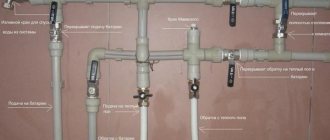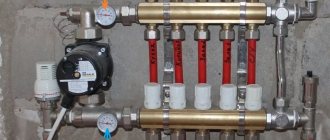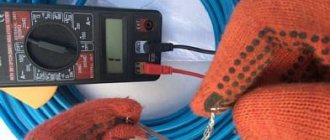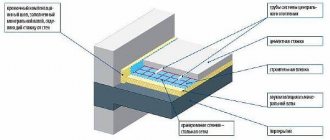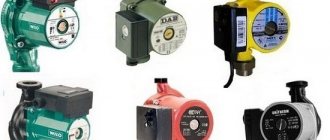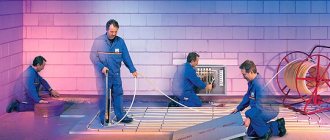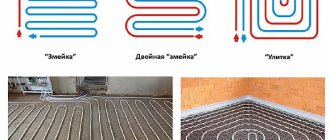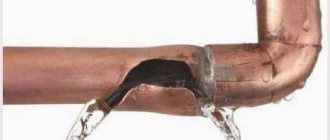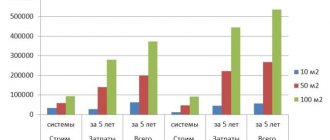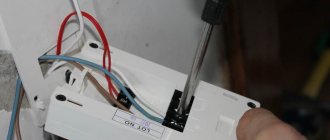How is the temperature of water floors regulated?
Without understanding the structure of a water floor, it is difficult to understand the purpose and operating principle of such a regulator.
To heat the floor covering, pipes are evenly laid underneath it, through which the coolant circulates. The ends of each pipe are connected to the inlet and outlet of the heating manifold. If there are heating radiators, they are connected there.
The room may have one or two floor heating circuits. Each of them is equipped with a valve at the inlet or outlet. Using it, you can change the amount of coolant passing through the pipe per unit time, thereby regulating the floor temperature.
Hot water moves through the pipes due to the pressure created by the circulation pump. By manipulating the common main valve, you can also regulate the temperature, but this will lead to a change in it in all circuits at the same time. Since not all of them work under the same conditions, this method is not used in practice.
Floor heating control
Thermal heads are an inexpensive and effective solution for controlling the temperature of the coolant in the floor circuit. The coolant leaves the boiler at a constant temperature of 70-90 degrees. You can achieve a comfortable floor temperature using thermostatic heads in the following ways:
- Perform periodic short-term supply of hot coolant to the floor circuit. The coolant fills the circuit and the flow stops until it cools down to the set limit.
- Install a system in which the coolant supply will be constant, but with cooled return water mixed into the supply.
A short-term supply system is installed in rooms with a small area. Usually these are bathrooms or floor areas covered with ceramics. A two-way valve equipped with a thermal head and a remote floor sensor is connected to the supply system. After filling the circuit, the floor warms up, the sensor is triggered, and the valve blocks the coolant flow. After the screed has cooled, the valve opens again and the system is filled with hot water. This design is an economical alternative to a mixing block when installing short heating systems. In this way, it is best to connect to the radiator heating return, since the entry of practically boiling water into the floor circuit is not welcome due to the risk of damage to the entire structure.
Experts have mistrust of the method of batch-feeding the circuit with hot water. The logic of the circuit is simple, but in practice not everything is so smooth. The main argument is uneven heating of the pipe. At the entrance the temperature will be 80, and at the exit, where the sensor was triggered, it will be 30. It is clear that such a floor will not warm up evenly. Therefore, a special pipe laying system is needed so that areas located closer to the entrance are laid next to the pipes on the supply side. This is another confirmation that such a scheme is not suitable for large rooms.
Valves with a thermal head of the RTL series, which do not have a remote sensor, are specially designed for heated floors. They are installed on the return pipe and maintain a constant temperature of the coolant, regardless of the floor temperature. They have the ability to adjust the upper temperature threshold (usually no higher than 40). When installing such models, you must adhere to the general installation rules. It is advisable to install the RTL head in a horizontal position. In this case, you cannot set the upper temperature threshold lower than the ambient temperature in the room. This system performs point “injections”, due to which a certain constancy of the coolant movement is maintained and there is no overheating of the circuit.
Connection diagram with three-way valve
In the second method, it is necessary to install a three-way valve with a thermal head and a floor sensor in the supply system. From the return pipe through a tee, a connection is made to the third outlet of the valve.
The thermal head is installed on the valve through a special locking axle box. When the sensor heats up, the valve stem moves, and a gap opens inside the body to allow cooled water from the return to mix in and the supply gap narrows. This way the system will constantly receive coolant at the set temperature. Due to the continuous flow of water, the floor surface will warm up to a comfortable 28 degrees. At the same time, you don’t have to worry that too high a temperature of the coolant may deteriorate the pipes or crack the screed. You cannot do without such a scheme if the heated floor is connected to the same mixer with a radiator circuit powered by the boiler.
In addition, the cold water mixing circuit is suitable for heating large rooms and will maintain a constant temperature.
Video on installing an electronic RTL thermal head from a radiator circuit on a balcony:
Thermal heads allow you to install inexpensive and small underfloor heating systems, while you can do without an expensive collector group.
average rating
more than 0 ratings
Share link
Why do you need a thermostat for heated floors?
All circuits are subject to individual regulation. If there are several rooms, as well as several separate circuits in one room, the task becomes more complicated. It cannot be solved by conventional methods - manually regulating the coolant pressure.
Firstly, heating systems are inertial. From the moment the valve turns until the established floor temperature stabilizes, a certain amount of time passes. If the user is not satisfied with the degree of heating, he will have to go and turn the valve again. What if there are a lot of them?
In addition, additional factors also influence the feeling of a comfortable temperature. The overall temperature in the room and the presence of drafts during its ventilation require constant adjustments. If the thermal insulation of the floor and walls is insufficient, the operation of heating systems depends on weather conditions. It is difficult for the owner of a heated floor to respond promptly to all this.
Manifold for home heating
Secondly, constant sharp manual adjustments can lead to the formation of air locks in the system. In this case, part of it ceases to function entirely.
And finally, thirdly: with manual control, it would not occur to anyone when leaving for work to reduce the temperature in order to save money. After all, upon returning, the setup process will have to start all over again. Even if you remember the position of the valves, after a month of such adjustments the owner will come to terms with the inevitable losses and stop saving.
Operation of the regulator for water heated floors
The temperature controller for underfloor heating mechanically performs the same operations. But it does this continuously, based on the readings of temperature sensors. As a result, the slightest change in it is immediately countered by a slight turn of the valve, which eliminates the appearance of air locks in the system.
There are two possible locations for temperature sensors. One of them is in the concrete floor screed next to the pipes. With this arrangement, the regulator stabilizes the temperature of the floor surface, maintaining its set value.
This control method is suitable for systems where the floors are additionally heated, and a separate circuit with heating radiators is used to maintain the air temperature in the room. For powerful and extended floor heating systems, this method is ineffective.
If floor heating is the only means of heating the room, and also if external factors have a significant influence on the feeling of comfort from heated floors, then thermostats with an outside air temperature sensor are used. Since it is built into the regulator body, certain requirements are imposed on the installation height of the control device.
The air temperature sensor is used as part of powerful heating systems. But it should be borne in mind that such an adjustment implies the absence of strong heat losses.
Tip: To increase the efficiency of underfloor heating, the room must have adequate thermal insulation.
Some models use both methods of temperature control: both floor and room air. The controller gives priority to the readings of the room sensor.
Heated floor temperature control sensors
The entire variety of sensors can be divided into two large groups:
- To control air temperature;
- For monitoring floor temperature.
The main types of thermostats for heated floors
Such sensors are installed in the thermostat housing. This technological solution is explained as follows: firstly, there is no need to install additional accessories for the heating system; secondly, the efficiency of heating control is significantly increased.
Layout of thermostat for water heated floors
Actuators
Sensors transmit data about the current temperature to the thermostat. It generates a control signal, which is sent via cable to the actuator - the servo drive.
This is the main difference between a water floor control system and an electric one. Here the regulator does not generate a constant signal to turn on the heater, but a changing control voltage supplied to the servo drive.
Inside the servo drive there is a heating element placed in a closed container filled with a special liquid. As the temperature rises, it increases in volume. At the same time, the pressure inside the tank increases. This force is transmitted to the rod, which blocks the flow part of the valve. When cooling, the processes occur in the opposite direction.
Two way valve with servo drive
Thus, the servo drive converts the control voltage into the valve closing degree and controls the coolant flow.
There are servos of normally closed and normally open types. The meaning of the name is what position the actuator will take in the absence of a control signal.
Three-way valve
There is another control method using a three-way valve. It is so called because it has three holes for connecting pipes. Control is also carried out using a servo drive.
Unlike the use of servo-controlled valves, a three-way valve does not shut off the main coolant flow. He diverts part of it to the return collector. What part of the coolant will go to the return line depends on the position of the valve set by the servo drive.
Three way valve
A system with such control devices is a little more complicated, since a pipeline for coolant overflow is added to each controlled circuit. If there is only one water heated floor, it is completely justified.
Advantages of using Salus Controls automation:
- Excellent compatibility of system components
- Modern design
- Cost reduction thanks to the use of the ERT50 “master thermostat” - non-programmable thermostats are controlled, i.e. programmed by one master thermostat.
- Easy installation and operation.
- Saving heating costs.
How does the control system work?
The water heated floor control system based on the Salus Expert series equipment consists of electronic components that were specially developed by Salus Controls to work together with each other. As soon as one of the thermostats detects a deviation of the room temperature from the set value, the KL06 controller (or its wireless analog KL06RF) turns on the necessary TA series control actuators. The five thermostat models available for this system can be combined to work with each other and connected to the controllers using four-wire cables, as shown in the diagram.
Types of thermostats
On the path from the sensor to the servo drive, the most complex device of the system is installed - a thermostat to control the temperature of the water heated floor. In this place there can be both simple and quite complex and expensive devices.
Electromechanical thermostats
The simplest type of thermostat. Accordingly - the cheapest. Of the controls, they contain the minimum possible: a disk, around the circumference of which there is a digital scale with temperature values. There is no indication of the current value of the adjustable parameter. Therefore, it is not possible to see how much the floor or room air temperature corresponds to reality.
Sometimes there is a lever on the regulator panel, by switching which the heating is turned off completely.
Electronic thermostats
These devices are more expensive than electromechanical ones. They have a display that shows either the current or set temperature. The task is performed by pressing the buttons to decrease or increase the parameter.
A separate subtype of these products are sensor devices. They differ from ordinary ones in that they are activated not by pressure, but by a light touch. And at an increased price.
Programmable thermostats
Outwardly, they are similar to electronic thermostats, since there is also a display on the front panel. But more buttons are used for control, since they contain many functions.
A programmable thermostat for underfloor heating allows you to change the set temperature depending on the time of day or days of the week. This makes it possible to reduce the intensity or even completely turn off the heating when it is not required.
For example, on weekday mornings the whole family leaves home: children go to kindergarten or school, adults go to work. There is no point in wasting thermal energy to maintain the operating temperature in the room; no one needs it.
At the set time, shortly before the residents return to their homes, the regulator timer will again return the system to the required operating mode. By manipulating temperature settings at different times of the year, the greatest possible savings can be achieved.
Among the programmable devices there are variations controlled by a remote control; it is also possible to access settings from a computer, tablet or mobile phone via a Wi-Fi network. Accordingly, as the number of possibilities increases, the price also increases, which already exceeds the cost of previously described devices.
Note: Comfort always costs money. To start saving on something, you will first need additional capital investment.
In addition, some programmable controllers allow you to control the operation of several heating circuits simultaneously. Moreover, temperature stabilization occurs in each circuit independently of the others. These devices are called multizone.
Electronic devices
All of the thermostats listed above are wired devices. Cable lines are used to connect the sensor with the controller, the controller with the servo drive, and supply power to the control circuit. And they need to be laid along the walls or inside them.
But sometimes this turns out to be impossible or not aesthetically pleasing. Especially for such cases, devices have been developed in which the cables are replaced by transmitters and receivers of radio control signals.
Electrical signals in such a system are transmitted wirelessly. The cost of the equipment is very high, so it is advisable to use it only in cases where laying cable lines is really impossible. Or the owner is able to significantly overpay for comfort.
Criteria for choosing thermostats
If there is only one heating circuit installed in a single floor heating room, a multi-zone thermostat is not needed. These are small rooms, which mainly include bathrooms and bathrooms. A simple electromechanical regulator is sufficient here.
It should also be used in cases where untrained users, for example, elderly people, will set the temperature. Just one adjustment, and also a mechanical one, will allow them to control floor heating without going too much into the nuances and subtleties of working with electronic devices.
Since electromechanical regulators are difficult to break, their use is indicated in families with small children.
In cases where large areas are heated, it is impossible to get by with one circuit for high-quality floor heating. Therefore, multi-zone thermostats should be used.
If, in addition, you plan to heat the floors in several rooms or throughout the house, it’s time to think about centralizing the control of the system. But in these cases, it is necessary to provide in advance routes for connecting the temperature sensors to the control unit. It turns out to be a whole project, which must also be connected to the location of the electrical wiring routes. Therefore, solving such a problem is possible only during construction or major renovation of premises. The possibility of integrating underfloor heating control into a smart home system is interesting.
But centralizing control also has its downsides. For people living in each specific room, it may be more convenient to have a personal thermostat just for that room.
If you want to save money by lowering the floor heating temperature or turning off the heating altogether when no one is in the house, you need to choose thermostats with the ability to program these events. But this will only be relevant when these events happen regularly and not sporadically.
